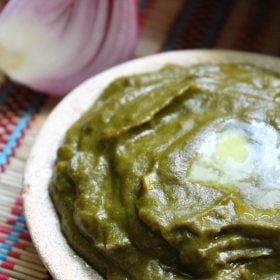When its that time of the year, when there’s a nip in the air and we get ready with all our winter wear, we Indians also look forward to Mother Nature’s bounty that this season brings along. Apart from many vegetables, the arrival of winters in India also mean that the markets are full of a variety of fresh seasonal greens. Chickpea greens or chana saag is one of the lesser-known specialties from North India. This Chane Ka Saag is thus, a North Indian/Punjabi style delicacy made of tender greens of the chickpea plant. This is also a vegan preparation.

About Chane Ka Saag
‘Saag’ in Punjabi or Hindi language is a general term for ‘greens’ or any ‘green leafy vegetable.’ Then, ‘chana’ is ‘chickpeas.’ So ‘chana saag’ or ‘chane ka saag’ are the tender greens of chickpea plant with small feathery leaves.
You might also come across a preparation or dish referred to as saag, which might be confusing for you. But take it this way that any dish also, which is called as saag, like this Chane Ka Saag, is ought to have a green leafy vegetable in it. The confusion will be less like this.
Like I mentioned in the beginning, fresh chickpea greens make an appearance in the Indian markets during winters. So, it is only during winters, you can make various recipes using these lovely tender greens. Thus, Chane Ka Saag too is a winter delicacy and usually made in the northern parts of India.
The recipe of Chane Ka Saag shared here tastes very different than Sarson Ka Saag. Making any leafy green-based recipe takes time. Plucking, rinsing, chopping and finally cooking the greens is quite a time-consuming task.
However, if you want to make saag, then you do have to spend some time in prepping them. But it’s worth the effort as the final dish is not only delicious but very nutritious also.
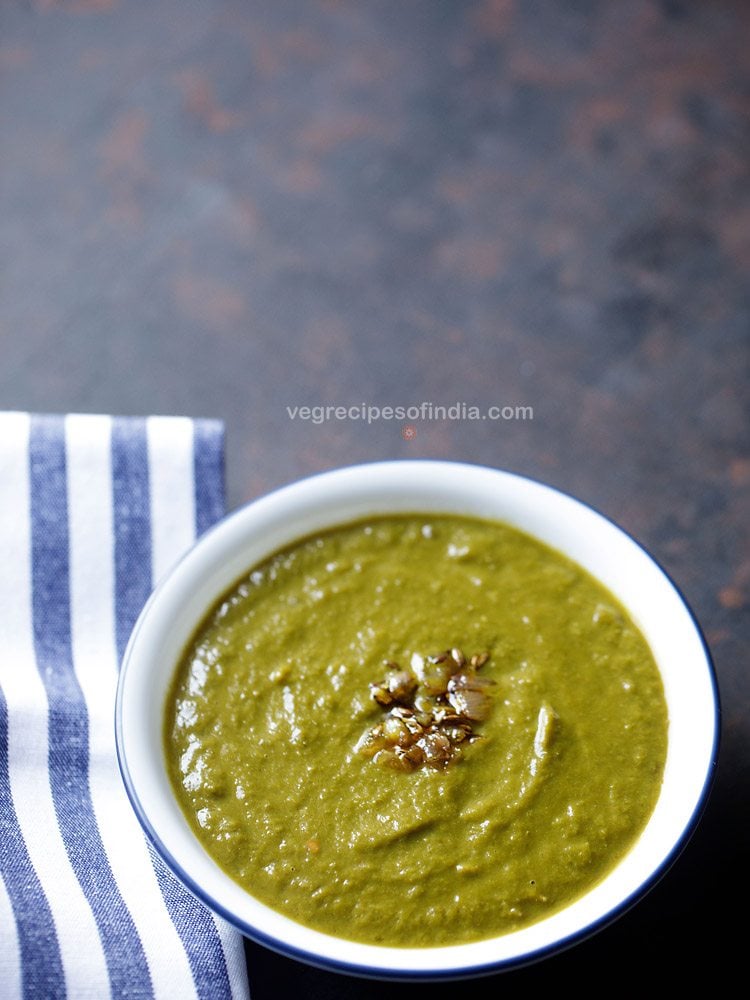
About This Recipe
To thicken this Chane Ka Saag, I have added moong dal (or split, husked green gram). You can also add makai ka atta (maize flour), besan (gram flour) or bajra atta (pearl millet flour) as a thickener.
This recipe yields a delicious and slightly sour tasting (khatta) saag, which pairs beautifully with Makki Ki Roti or Bajre Ki Roti. You can also serve it with your regular chapatis or roti.
Making Chane Ka Saag is easy and it is just the preparation that takes time. I clean the greens one day before, keep them in an air-tight cotton bag or container and refrigerate it. So, half of the work is over. Then, the next day, it is much easy to just cook the saag.
Chane Ka Saag can be topped with homemade safed makhan (white butter) or Ghee and served with your choice of flatbread. It tastes the best with Makki Roti and Bajra Roti, and when paired with these, makes for a sumptuous, comforting and wholesome meal.
How to make Chane Ka Saag
Cleaning and Prepping Saag
1. Firstly, pluck the tender stems with the leaves from the saag. Do not use the hard or dense stems. Collect the tender small stems with the small leaves in pan or large bowl.
You will need 150 grams cleaned chana saag or 5 to 5.5 cups chane ka saag.
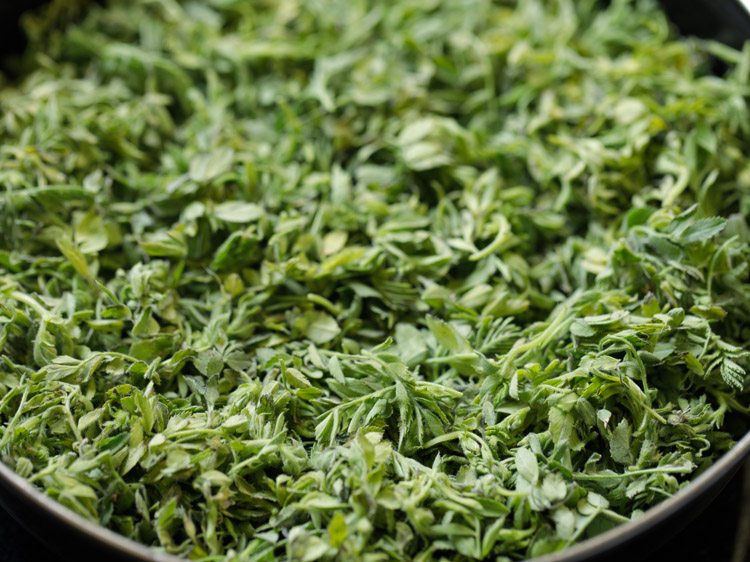
2. Now, add water in the pan or bowl and let the chane ka saag be immersed for 2 to 3 minutes. Doing this helps to get rid of the mud or dust on the saag as these settle down in the water.
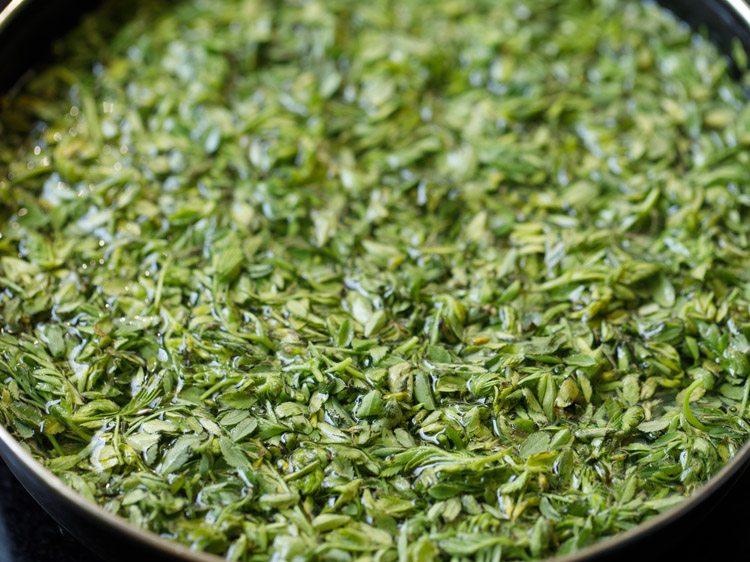
3. Drain all the water.

4. Again pour water in the bowl or pan.
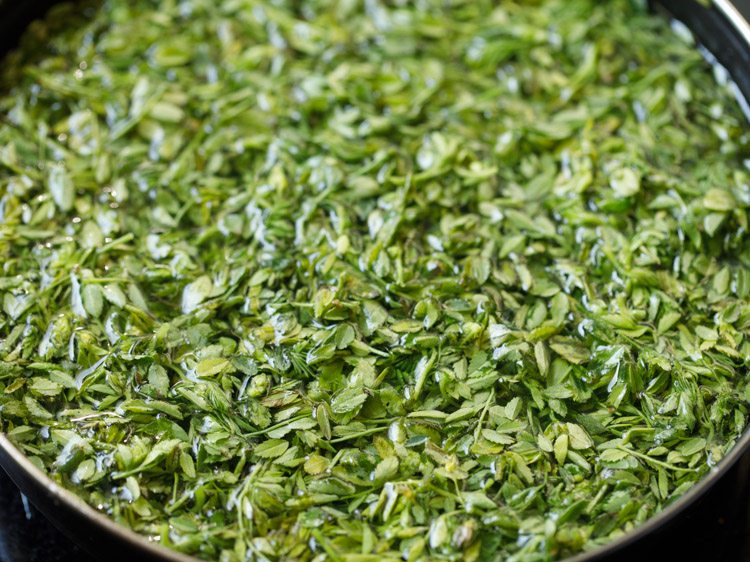
5. Gently swirl the saag with your hands and then drain the water. Repeat this method 2 to 3 times, so that the saag is cleaned properly.

6. Lastly, drain all the water well from the saag.
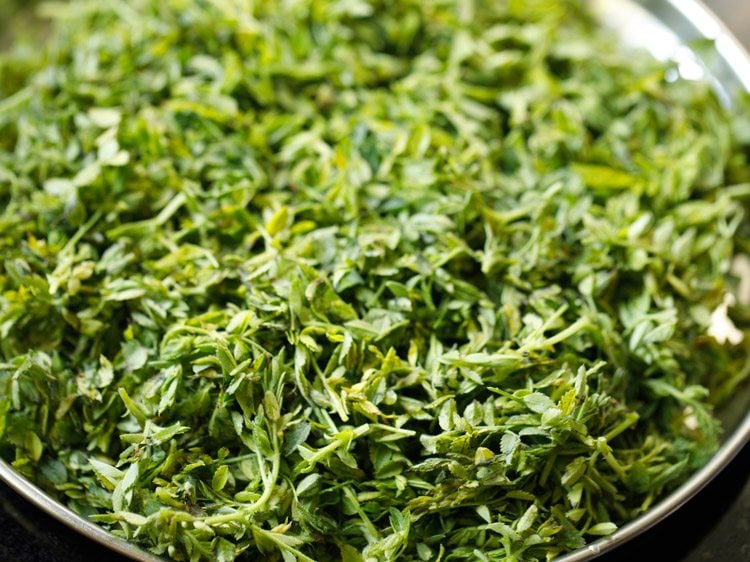
7. Roughly chop the saag.

Pressure Cooking Chana Saag
8. In a 3-liter stovetop pressure cooker, add the chopped saag.

9. Add 2 tablespoons rinsed moong dal. Instead of moong dal, you can add maize flour, gram flour or pearl millet flour.
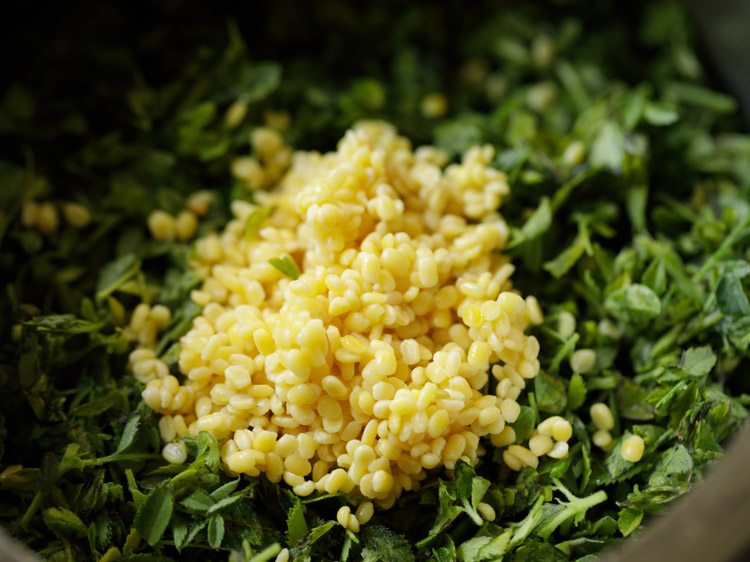
10. Add 1 medium quartered tomato, 1 teaspoon chopped ginger, 1 teaspoon chopped garlic and 1 green chili (about 1 teaspoon, chopped).

11. Add 1 pinch asafoetida (hing) and salt as required.

12. Add ½ cup water.
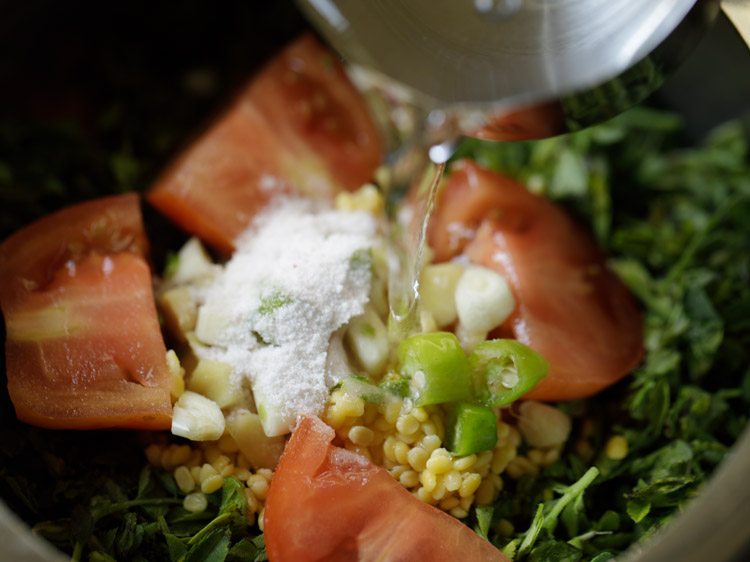
13. Pressure cook on medium heat for 8 to 9 minutes or 4 to 5 whistles. Since I have used moong dal, I have pressure cooked for more time.
If using any of the flours instead of moong dal, then you can pressure cook for about 5 to 6 minutes.

14. When the pressure settles down naturally, open the lid. Keep it open so that the saag mixture becomes warm or cools down.
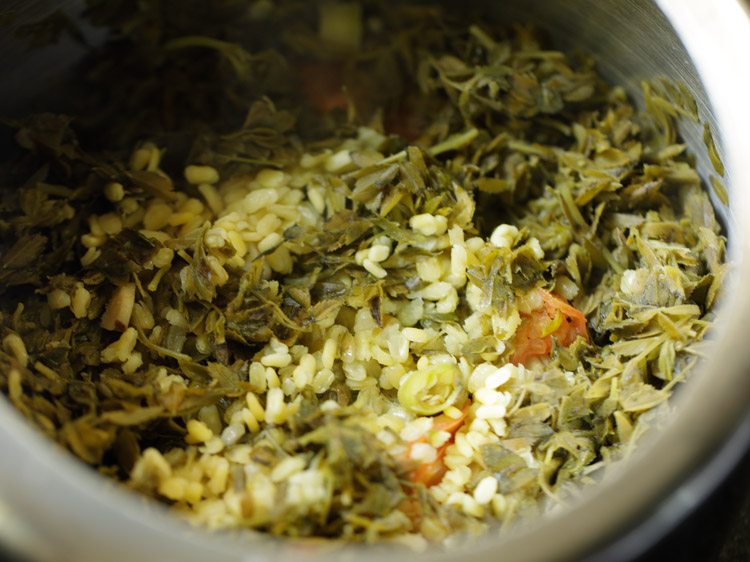
15. When the saag mixture has become warm or cooled, take it in a mixer-grinder jar or blender. You can also blend directly in the cooker with a hand held electric blender.
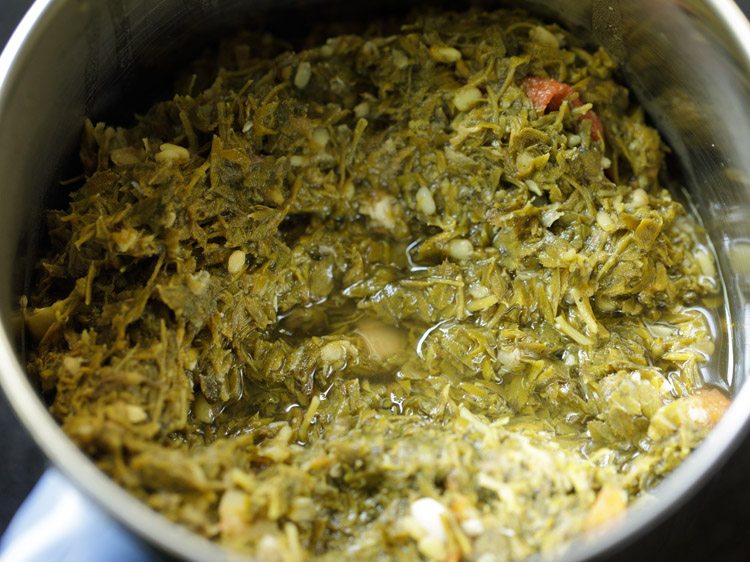
16. Blend to a smooth consistency. Set aside.

Tempering Chane Ka Saag
17. Heat 2 tablespoons mustard oil in a pan or kadai. You can also use ghee instead of mustard oil.
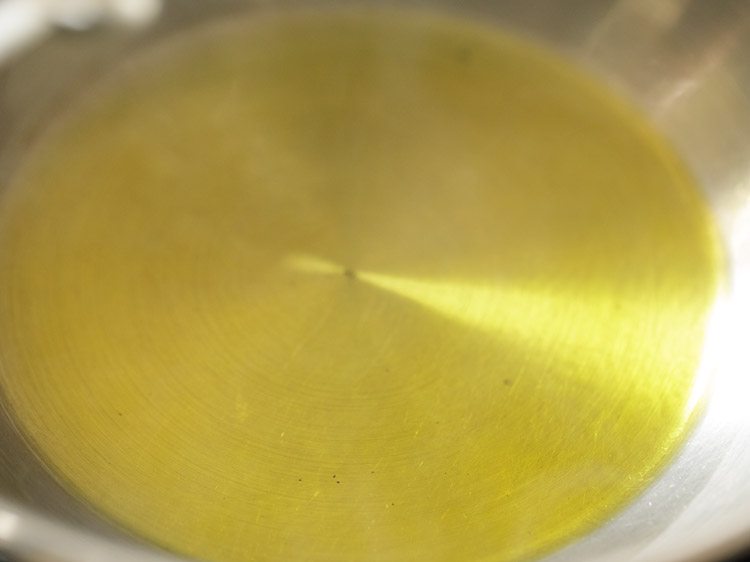
18. Add ½ teaspoon cumin seeds. Keep the heat to a low.

19. Let the cumin seeds crackle.
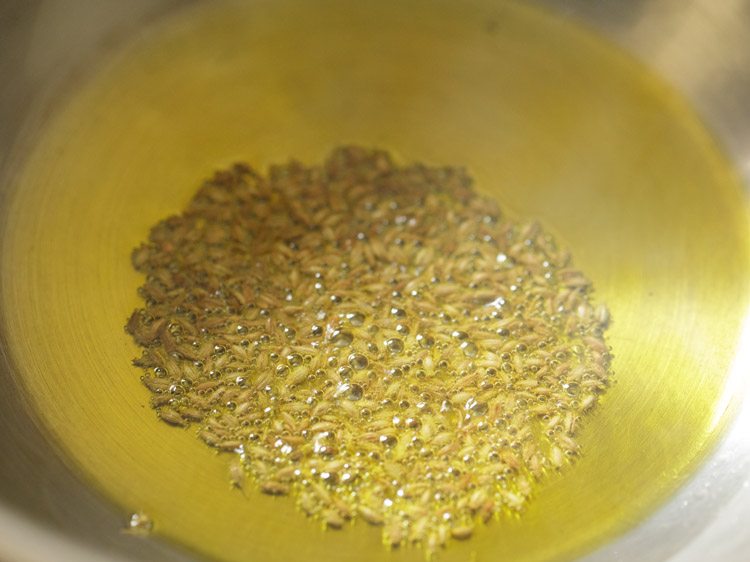
20. Then, add 1 dried red chili (broken and seeds removed) and 1 pinch asafoetida (hing). Stir till the red chilies change color.
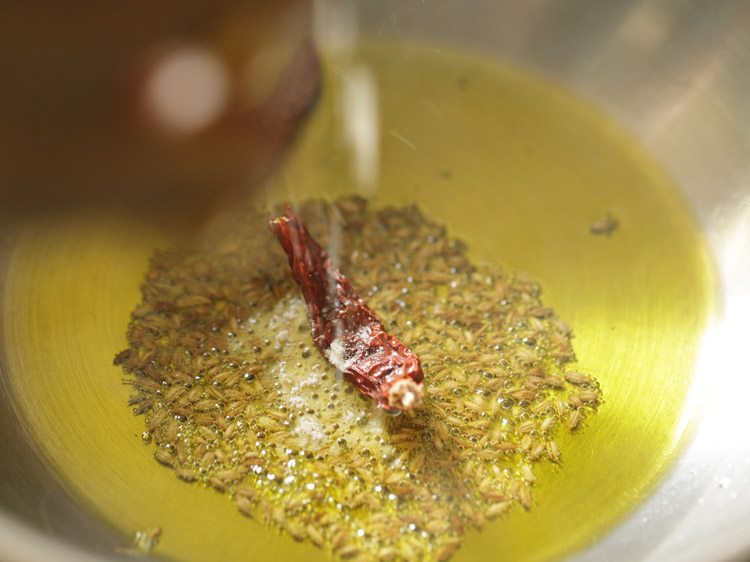
21. Then, add ⅓ cup finely chopped onions.
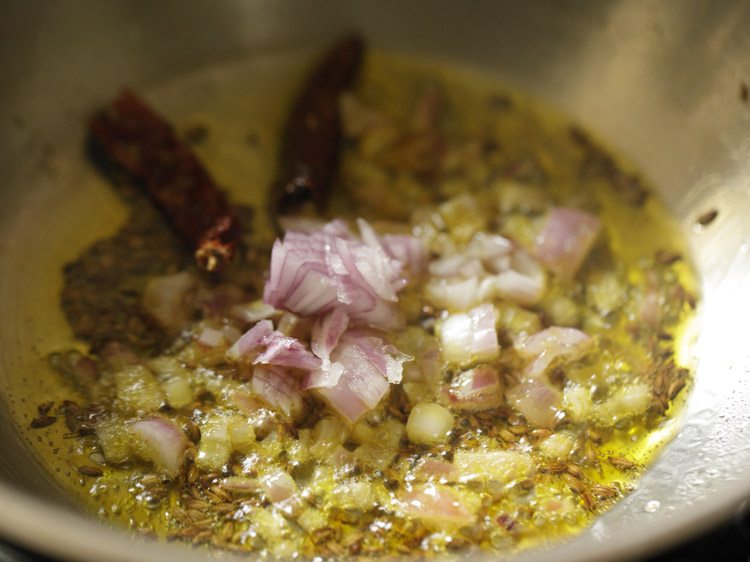
22. Begin to sauté onions on low to medium heat.
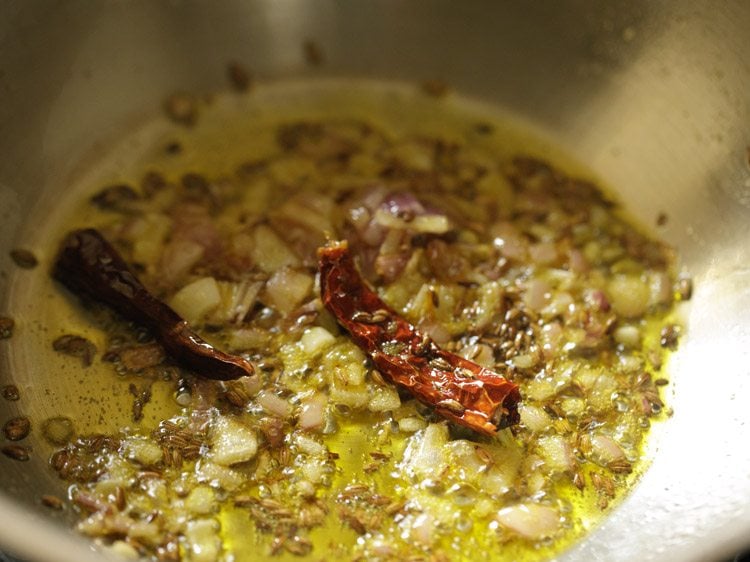
23. Sauté onions till light brown or golden.

23. Add the saag puree.
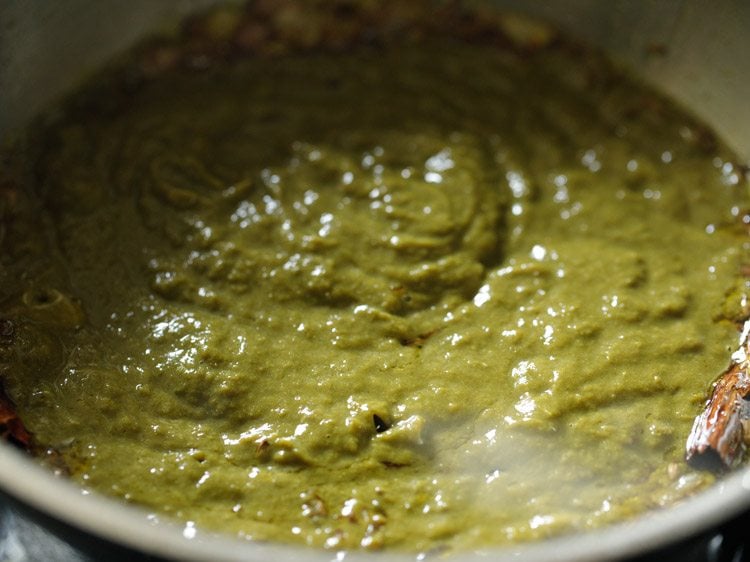
24. Mix very well and simmer for 3 to 4 minutes or till it becomes hot.
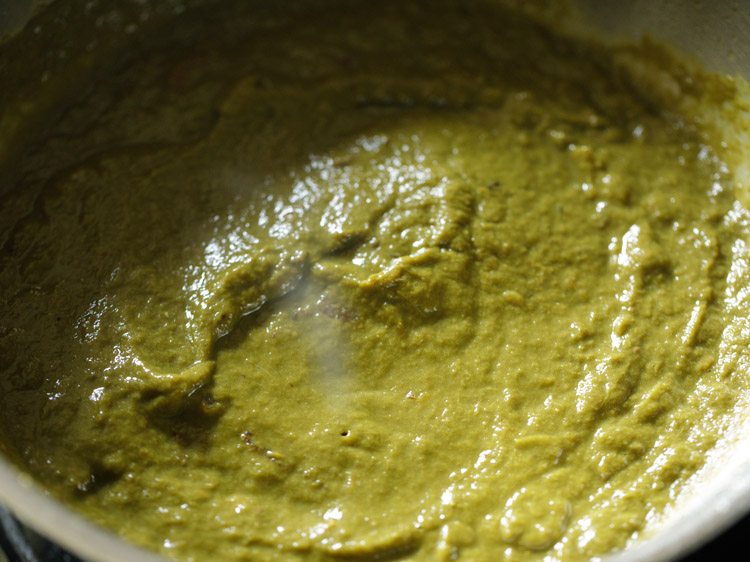
25. While simmering, stir often as the saag splutters. Later, switch off the heat.
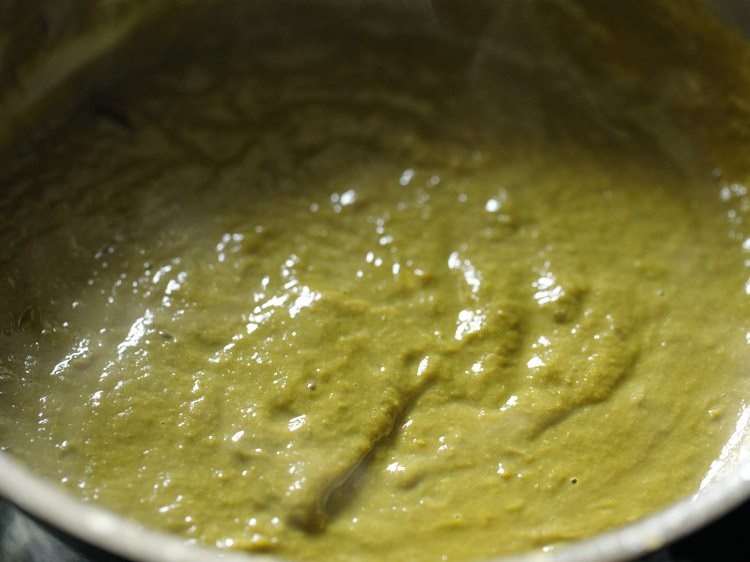
26. Serve Chane Ka Saag with makki ki roti, bajre ki roti, chapatis or phulka.

Expert Tips
- Take the tender stems from the saag, and not the dense or hard stems.
- Keeping the chana saag immersed in water for some minutes, then rinsing and draining, and repeating this process 2 to 3 times is important as this helps to get rid of the mud or dust on the saag and cleans it completely.
- Moong dal is used in this recipe as a thickener. Instead of moong dal, you can even use gram flour, maize flour, sorghum flour or pearl millet flour.
- The pressure-cooking time will increase if you add moong dal. But if you add any of the other above-mentioned flour alternatives, then the cooking time will reduce.
- The pressure cooked saag mixture can be blended in a mixer-grinder, blender or with a hand-held electric blender.
- You can cook this dish in ghee (clarified butter), instead of mustard oil.
More Greens To Try!
Palak Recipes (Spinach Recipes)
Palak Recipes (Spinach Recipes)
Methi Recipes (Fenugreek)
Palak Recipes (Spinach Recipes)
Please be sure to rate the recipe in the recipe card or leave a comment below if you have made it. For more vegetarian inspirations, Sign Up for my emails or follow me on Instagram, Youtube, Facebook, Pinterest or Twitter.

Chane ka Saag
Ingredients
For pressure cooking saag
- 150 grams chana saag (cleaned) or 5 to 5.5 cups chane ka saag – tender chickpea leaves
- 2 tablespoons moong dal – husked & split mung lentils
- 1 tomato (medium-sized), quartered
- 1 inch ginger or 1 teaspoon chopped ginger
- 3 to 4 garlic cloves (medium-sized) or 1 teaspoon chopped garlic
- 1 green chili or 1 teaspoon, chopped
- 1 pinch asafoetida (hing)
- ½ cup water
- salt as required
For tempering chane ka saag
- 2 tablespoons mustard oil
- ½ teaspoon cumin seeds
- 1 dry red chili – broken and seeds removed
- 1 pinch asafoetida (hing)
- ⅓ cup onions (finely chopped) or 1 medium-sized onion
Instructions
Preparation
- Firstly pluck the tender stems with leaves from the saag. Do not use the hard or dense stems. Collect the tender small stems with leaves in pan or large bowl.
- Now add water in the pan or bowl and let the chane ka saag be immersed in the water for 2 to 3 minutes. Doing this helps to get rid of the mud or dust on the saag as these settle down in the water.
- Drain all the water. again pour water in the bowl or pan.
- Gently swirl the saag with your hands and then drain the water. Do this method 2 to 3 times more so that the saag is cleaned properly.
- Now drain all the water very well from the saag. Chop the saag.
Pressure cooking chana saag
- In a 3 litre pressure cooker, take the chopped saag.
- Add 2 tablespoons rinsed moong dal. Instead of moong dal, you can add makai ka atta (maize flour) or besan (gram flour) or bajra atta (sorghum flour)
- Add 1 medium tomato (quartered), 1 teaspoon chopped ginger, 1 teaspoon chopped garlic and 1 green chili.
- Add 1 pinch asafoetida or salt as required. add ½ cup water.
- Pressure cook for 8 to 9 minutes or 4 to 5 whistles. Since I have used moong dal I have pressure cooked for more time. If using any of the flours mentioned above instead of moong dal, then you can pressure cook for about 5 to 6 minutes.
- When the pressure settles down on its own, open the lid. Keep it open so that the saag mixture becomes warm or cools down.
- When the saag mixture has become warm or cooled down, take it in a mixer-grinder jar or blender. You can also blend directly in the cooker with a hand held electric blender.
- Blend to a smooth consistency. Keep saag aside.
Tempering chane ka saag
- Heat 2 tablespoons mustard oil in a pan or kadai. Add ½ teaspoon cumin seeds.
- Let the cumin seeds crackle. then add 1 dry red chili (broken and seeds removed) and 1 pinch asafoetida (hing).
- Stir till the red chilies change color. Then add ⅓ cup finely chopped onions.
- Sauté onions till light brown or golden. Add the blended chana saag.
- Mix very well and simmer chane ka saag for 3 to 4 minutes or till it becomes hot.
- While simmering do stir often as the saag splutters. Later switch off the flame.
- Serve chane ka saag with makki ki roti or bajre ki roti or chapati or phulka.
Notes
- Use the tender stems with the leaves and not dense or hard stems.
- Clean and rinse the saag very well in water.
- Instead of mustard oil, use any neutral flavored oil. You can also use butter or ghee.
Nutrition Info (Approximate Values)
This Chane ka Saag post from the archives first published on January 2018 has been republished and updated on November 2022.



